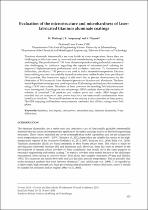 ResearchSpace
ResearchSpace
Evaluation of the microstructure and microhardness of laser-fabricated titanium aluminate coatings
JavaScript is disabled for your browser. Some features of this site may not work without it.
- ResearchSpace
- →
- Research Publications/Outputs
- →
- Conference Publications
- →
- View Item
| dc.contributor.author |
Tlotleng, Monnamme

|
|
| dc.contributor.author |
Lengopeng, T

|
|
| dc.contributor.author |
Pityana, Sisa L

|
|
| dc.date.accessioned | 2017-04-10T10:33:33Z | |
| dc.date.available | 2017-04-10T10:33:33Z | |
| dc.date.issued | 2016-10 | |
| dc.identifier.citation | Tlotleng, M., Lengopeng, T. and Pityana, S. 2016. Evaluation of the microstructure and microhardness of laser-fabricated titanium aluminate coatings. In: AMI Ferrous and Base Metals Development Network Conference 2016, 19-21 October 2016, Southern Sun Elangeni Maharani, KwaZulu-Natal | en_US |
| dc.identifier.uri | http://hdl.handle.net/10204/8994 | |
| dc.description | AMI Ferrous and Base Metals Development Network Conference 2016, 19-21 October 2016, Southern Sun Elangeni Maharani, Kwazulu-Natal | en_US |
| dc.description.abstract | Titanium aluminide intermetallics are very brittle at room temperature, hence they are challenging to fabricate even by conventional manufacturing techniques such as casting and forging. The production of TiAl from elemental powders using industrial processes is also challenging; in particular regarding the aspects of microstructural tailoring for improved high-temperature performance and oxidation resistance. To circumvent the difficulties, pre-alloyed TiAl powders are used to make industrial components. Electron beam melting was used successfully to produce miniature turbine blades from pre-alloyed TiAl powders. The innovative aspect of this work lies in process development for the fabrication of TiAl materials from elemental powders of titanium and aluminum. The laser metal deposition technique was used to produce TiAl coatings on titanium alloy substrates using a 3 kW laser system. The effects of laser power on the resulting TiAl microstructure were investigated. Scanning electron microscopy (SEM) analysis showed the inclusion of colonies of unmelted TiAl particles and surface pores and cracks. SEM images also revealed that an increase in laser power leads to a microstructural transformation from lamellar to dendritic. The overall hardness of the coating is also a function of laser power. The EDS mapping and hardness measurements confirmed that all the coatings were TiAl phase. | en_US |
| dc.language.iso | en | en_US |
| dc.relation.ispartofseries | Workflow;18034 | |
| dc.subject | Titanium aluminide intermetallics | en_US |
| dc.subject | Titanium coatings | en_US |
| dc.subject | Hardness | en_US |
| dc.subject | Heat inputs | en_US |
| dc.subject | Laser power | en_US |
| dc.subject | Microstructure | en_US |
| dc.subject | Titanium aluminide | en_US |
| dc.subject | X-ray | en_US |
| dc.title | Evaluation of the microstructure and microhardness of laser-fabricated titanium aluminate coatings | en_US |
| dc.type | Conference Presentation | en_US |
| dc.identifier.apacitation | Tlotleng, M., Lengopeng, T., & Pityana, S. L. (2016). Evaluation of the microstructure and microhardness of laser-fabricated titanium aluminate coatings. http://hdl.handle.net/10204/8994 | en_ZA |
| dc.identifier.chicagocitation | Tlotleng, Monnamme, T Lengopeng, and Sisa L Pityana. "Evaluation of the microstructure and microhardness of laser-fabricated titanium aluminate coatings." (2016): http://hdl.handle.net/10204/8994 | en_ZA |
| dc.identifier.vancouvercitation | Tlotleng M, Lengopeng T, Pityana SL, Evaluation of the microstructure and microhardness of laser-fabricated titanium aluminate coatings; 2016. http://hdl.handle.net/10204/8994 . | en_ZA |
| dc.identifier.ris | TY - Conference Presentation AU - Tlotleng, Monnamme AU - Lengopeng, T AU - Pityana, Sisa L AB - Titanium aluminide intermetallics are very brittle at room temperature, hence they are challenging to fabricate even by conventional manufacturing techniques such as casting and forging. The production of TiAl from elemental powders using industrial processes is also challenging; in particular regarding the aspects of microstructural tailoring for improved high-temperature performance and oxidation resistance. To circumvent the difficulties, pre-alloyed TiAl powders are used to make industrial components. Electron beam melting was used successfully to produce miniature turbine blades from pre-alloyed TiAl powders. The innovative aspect of this work lies in process development for the fabrication of TiAl materials from elemental powders of titanium and aluminum. The laser metal deposition technique was used to produce TiAl coatings on titanium alloy substrates using a 3 kW laser system. The effects of laser power on the resulting TiAl microstructure were investigated. Scanning electron microscopy (SEM) analysis showed the inclusion of colonies of unmelted TiAl particles and surface pores and cracks. SEM images also revealed that an increase in laser power leads to a microstructural transformation from lamellar to dendritic. The overall hardness of the coating is also a function of laser power. The EDS mapping and hardness measurements confirmed that all the coatings were TiAl phase. DA - 2016-10 DB - ResearchSpace DP - CSIR KW - Titanium aluminide intermetallics KW - Titanium coatings KW - Hardness KW - Heat inputs KW - Laser power KW - Microstructure KW - Titanium aluminide KW - X-ray LK - https://researchspace.csir.co.za PY - 2016 T1 - Evaluation of the microstructure and microhardness of laser-fabricated titanium aluminate coatings TI - Evaluation of the microstructure and microhardness of laser-fabricated titanium aluminate coatings UR - http://hdl.handle.net/10204/8994 ER - | en_ZA |





